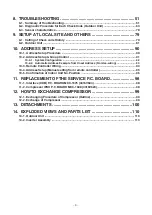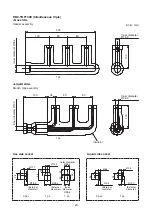
– 8 –
WARNING
(
∗
1) Refer to the “Definition of Qualified Installer or Qualified Service Person.”
General
Before starting to repair the air conditioner, read carefully through the Service Manual, and repair
the air conditioner by following its instructions.
Only qualified service person (
∗
1) is allowed to repair the air conditioner.
Repair of the air conditioner by unqualified person may give rise to a fire, electric shocks, injury,
water leaks and/or other problems.
Only a qualified installer (
∗
1) or qualified service person (
∗
1) is allowed to carry out the electrical
work of the air conditioner.
Under no circumstances must this work be done by an unqualified individual since failure to carry
out the work properly may result in electric shocks and/or electrical leaks.
Wear protective gloves and safety work clothing during installation, servicing and removal.
When connecting the electrical wires, repairing the electrical parts or undertaking other electrical
jobs, wear gloves to provide protection for electricians, insulating shoes and clothing to provide
protection from electric shocks.
Failure to wear this protective gear may result in electric shocks.
Use wiring that meets the specifications in the Installation Manual and the stipulations in the local
regulations and laws.
Use of wiring which does not meet the specifications may give rise to electric shocks, electrical
leakage, smoking and/or a fire.
Only a qualified installer (
∗
1) or qualified service person (
∗
1) is allowed to undertake work at
heights using a stand of 50 cm or more.
When working at heights, use a ladder which complies with the ISO 14122 standard, and follow
the procedure in the ladder’s instructions.
Also wear a helmet for use in industry as protective gear to undertake the work.
When working at heights, put a sign in place so that no-one will approach the work location,
before proceeding with the work.
Parts and other objects may fall from above, possibly injuring a person below.
Do not touch the aluminum fin of the outdoor unit.
You may injure yourself if you do so. If the fin must be touched for some reason, first put on
protective gloves and safety work clothing, and then proceed.
Do not climb onto or place objects on top of the outdoor unit.
You may fall or the objects may fall off the outdoor unit and result in injury.
When transporting the air conditioner, wear shoes with additional protective toecap.
When transporting the air conditioner, do not hold the bands around the packing carton.
You may injure yourself if the bands should break.
This air conditioner has passed the pressure test as specified in IEC 60335-2-40 Annex EE.
Electric
shock hazard
Prohibition
Stay on
protection
When you access inside of the electric cover to repair electric parts, wait for about five minutes
after turning off the breaker. Do not start repairing immediately. Otherwise you may get electric
shock by touching terminals of high-voltage capacitors. Natural discharge of the capacitor takes
about five minutes.
Place a
When checking the electric parts, removing the cover of the electric parts box of Indoor Unit and/
or front panel of Outdoor Unit inevitably to determine the failure, put a sign “Do not enter” around
the site before the work. Failure to do this may result in third person getting electric shock.
Before operating the air conditioner after having completed the work, check that the electrical
parts box cover of the indoor unit and service panel of the outdoor unit are closed, and set the
circuit breaker to the ON position. You may receive an electric shock if the power is turned on
without first conducting these checks.
“Work in progress” sign near the circuit breaker while the installation, maintenance, repair,
or removal work is being carried out.
There is a danger of electric shocks if the circuit breaker is set to ON by mistake.
If, in the course of carrying out repairs, it becomes absolutely necessary to check out the
electrical parts with the electrical parts box cover of one or more of the indoor units and the
service panel of the outdoor unit removed in order to find out exactly where the trouble lies, wear
insulated heat-resistant gloves, insulated boots and insulated work overalls, and take care to
avoid touching any live parts.
You may receive an electric shock if you fail to heed this warning. Only qualified service person
(
∗
1) is allowed to do this kind of work.









































